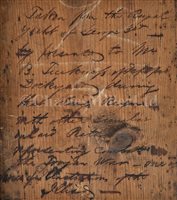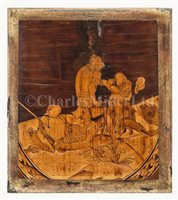3rd Nov, 2015 12:00
Maritime and Scientific Models, Instruments & Art ('Encounter')
67
[M] A SET OF FIVE MARQUETRY PANELS FROM THE ROYAL...
walnut with ink lined satinwood inlay depicting scenes from Homer's Illiad, framed within feigned oak leaf ovals, one inscribed on the reverse Taken from the Royal Yacht of George 3rd. Presented to Mr. B. Tuckness of Deptford Dockyard during that Kings Reign with other similar inlaid pictures representing combats in the Trojan War -- one of [a] of a series of illustrations from Homers Illiad ' , another with applied manscript provenance, two now cut down -- 14 x 11in. (35.5 x 28cm.) and 8½ x 7in. (21.5 x 18cm.) mounted on gilt supports for wall hanging.
(5)
Provenance: Bartholomew Tuckness; Charlotte Tuckness (wife of Charles Tuckness) to Rev. J. Salwey, Broxbourne, April 1892; US Private Collection.
Bartholomew Tuckness (1750-1822) was a joiner located in King Street, Deptford, who founded the firm of Tuckness & Huntley. It seems he was employed by the yard before founding his firm and retained strong connections, the Royal Charlotte being broken up at Deptford in 1820 having been laid up since 1804.
Royal Caroline, principal yacht to King George II and named in honour of his wife Caroline (of Ansbach), was built at Deptford by Mr. J. Allin in 1749. Designed as a sixth-rate mounting 10-3pdrs. and 8-pdr. swivel guns, she was measured at 232 tons burden with a 90 foot gundeck and a 24 foot beam. The largest royal yacht to date and the only such vessel to exceed 200 tons until Royal Sovereign was launched in 1804, she was one of the most sumptuous and expensively decorated vessels ever constructed. Whilst the Admiralty had ordered her, they had not budgeted for her and the niggling correspondence that ensued throws interesting light onto the lavish decor - nearly £1200 for carvings with 120,000 sheets of gold leaf costing a further £1521; £200 for curtains and silks; £18 for the stern lantern and numerous other expenses. A note sent by a carpenter called John Bladwell, sent to George Jackson of the Navy Office from March 1750 may mention, in part at least, the lot offered here: Sir - I was favour'd with yours[.] the hanging for his Majesty's Room is gone Down and the other 21 Panels will all be finished Satterday [sic] Morning without fail. At that time a typical seaman received £12 per annum and her full ship rig required a crew of 70 men to handle. George II's frequent visits to Hanover meant that she was in constant use ferrying him to and from the continent and she remained a firm favourite with the King until his death in 1760. When the new King, George III, chose Princess Charlotte of Mecklenburg to be his Queen, Royal Caroline was renamed Royal Charlotte in her honour and was the obvious vessel to convey the new bride to England. After the Princess Augusta was launched in 1771, Royal Charlotte lost her place as the most favoured royal yacht but continued in service. The Napoleonic Wars curtailed her use however and other than carrying the King on the occasional holiday trip to Weymouth between 1801-04, she was mostly laid up at Deptford and finally broken up there in 1820 where presumably a quantity of her fittings were sold off - it's no surprise an established supplier such as Mr Tuckness was able to acquire these very rare souvenirs which give a small hint of the quality alluded to in the Admiralty correspondence.
Sold for £2,728
Estimated at £3,000 - £4,000
(inc. buyer's premium of 24%)
Condition Report
Some fading to ink detailing, one of the smaller panels warped a little.
We are pleased to provide you with a general report of the condition of this property. Since we are not professional conservators or restorers, we urge you to consult with a restorer or conservator of your choice who will be better able to provide a detailed, professional report. Prospective buyers should inspect each lot to satisfy themselves as to condition and must understand that any statement made by Charles Miller Ltd is merely a subjective, qualified opinion. Prospective buyers should also refer to any Important Notices regarding this sale, which are printed in the Sale Catalogue. NOTWITHSTANDING THIS REPORT OR ANY DISCUSSIONS CONCERNING A LOT, ALL LOTS ARE OFFERED AND SOLD “AS IS” IN ACCORDANCE WITH THE CONDITIONS OF BUSINESS PRINTED IN THE SALE CATALOGUE.
walnut with ink lined satinwood inlay depicting scenes from Homer's Illiad, framed within feigned oak leaf ovals, one inscribed on the reverse Taken from the Royal Yacht of George 3rd. Presented to Mr. B. Tuckness of Deptford Dockyard during that Kings Reign with other similar inlaid pictures representing combats in the Trojan War -- one of [a] of a series of illustrations from Homers Illiad ' , another with applied manscript provenance, two now cut down -- 14 x 11in. (35.5 x 28cm.) and 8½ x 7in. (21.5 x 18cm.) mounted on gilt supports for wall hanging.
(5)
Provenance: Bartholomew Tuckness; Charlotte Tuckness (wife of Charles Tuckness) to Rev. J. Salwey, Broxbourne, April 1892; US Private Collection.
Bartholomew Tuckness (1750-1822) was a joiner located in King Street, Deptford, who founded the firm of Tuckness & Huntley. It seems he was employed by the yard before founding his firm and retained strong connections, the Royal Charlotte being broken up at Deptford in 1820 having been laid up since 1804.
Royal Caroline, principal yacht to King George II and named in honour of his wife Caroline (of Ansbach), was built at Deptford by Mr. J. Allin in 1749. Designed as a sixth-rate mounting 10-3pdrs. and 8-pdr. swivel guns, she was measured at 232 tons burden with a 90 foot gundeck and a 24 foot beam. The largest royal yacht to date and the only such vessel to exceed 200 tons until Royal Sovereign was launched in 1804, she was one of the most sumptuous and expensively decorated vessels ever constructed. Whilst the Admiralty had ordered her, they had not budgeted for her and the niggling correspondence that ensued throws interesting light onto the lavish decor - nearly £1200 for carvings with 120,000 sheets of gold leaf costing a further £1521; £200 for curtains and silks; £18 for the stern lantern and numerous other expenses. A note sent by a carpenter called John Bladwell, sent to George Jackson of the Navy Office from March 1750 may mention, in part at least, the lot offered here: Sir - I was favour'd with yours[.] the hanging for his Majesty's Room is gone Down and the other 21 Panels will all be finished Satterday [sic] Morning without fail. At that time a typical seaman received £12 per annum and her full ship rig required a crew of 70 men to handle. George II's frequent visits to Hanover meant that she was in constant use ferrying him to and from the continent and she remained a firm favourite with the King until his death in 1760. When the new King, George III, chose Princess Charlotte of Mecklenburg to be his Queen, Royal Caroline was renamed Royal Charlotte in her honour and was the obvious vessel to convey the new bride to England. After the Princess Augusta was launched in 1771, Royal Charlotte lost her place as the most favoured royal yacht but continued in service. The Napoleonic Wars curtailed her use however and other than carrying the King on the occasional holiday trip to Weymouth between 1801-04, she was mostly laid up at Deptford and finally broken up there in 1820 where presumably a quantity of her fittings were sold off - it's no surprise an established supplier such as Mr Tuckness was able to acquire these very rare souvenirs which give a small hint of the quality alluded to in the Admiralty correspondence.
Auction: Maritime and Scientific Models, Instruments & Art ('Encounter'), 3rd Nov, 2015






